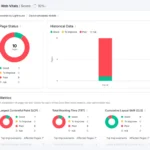
Introduction
Search engines today are smarter than ever. Gone are the days when simply stuffing a few keywords could get your page to rank. In 2025, Semantic SEO is what separates high-ranking, authoritative content from generic web pages.
But what exactly is Semantic SEO, and how does it help search engines understand context, not just keywords? Let’s dive deep into this concept and explore how you can use it to build stronger content strategies, improve rankings, and future-proof your website for AI-driven search.
What Is Semantic SEO?
Semantic SEO is the process of optimizing your content for meaning and context, not just for keywords.
It’s about helping search engines like Google understand the intent behind a search query and how the information on your website relates to that intent. Instead of focusing on one keyword (e.g., “running shoes”), semantic optimization covers related concepts such as “marathon gear,” “best sneakers for runners,” or “shoe cushioning technology.”
By creating content that explores a topic holistically, you build topical authority — a key factor Google now uses to decide which pages deserve top positions in search results.
The Shift From Keywords to Context
In the early days of SEO, Google’s algorithm matched search queries to exact words in a page’s content. However, this approach often failed to deliver relevant results.
Over the past decade, major algorithm updates like Hummingbird (2013), RankBrain (2015), BERT (2019), and the introduction of MUM (2021) have transformed how search works.
These updates introduced semantic search, powered by Natural Language Processing (NLP) and machine learning, allowing Google to:
- Understand user intent behind a query
- Recognize relationships between entities (people, places, topics, brands)
- Deliver more accurate, context-aware results
For example, when someone searches “how to make coffee without a machine,” Google no longer just looks for pages containing those exact words — it identifies the intent: making coffee manually — and shows guides on using a French press or stovetop method.
How Search Engines Understand Context
Search engines now use a combination of semantic mapping and entity recognition to interpret meaning. Let’s break this down:
1. Entities and Relationships
An entity is anything that has a distinct meaning — like “Apple” (the company), “iPhone,” or “Steve Jobs.”
Google identifies relationships between entities using its Knowledge Graph, a massive database that connects billions of concepts.
When your content clearly relates to recognized entities, it becomes easier for Google to classify and rank it accurately.
2. Natural Language Processing (NLP)
Google’s NLP algorithms analyze sentence structure, synonyms, and contextual cues. They can determine whether you’re talking about “jaguar the car” or “jaguar the animal” based on surrounding text.
3. Search Intent Classification
Semantic SEO aligns content with search intent — whether users want information (informational), to buy something (transactional), or to compare options (commercial).
Search engines reward pages that fulfill intent completely and clearly.
Why Semantic SEO Matters in 2025
In 2025, search is increasingly AI-driven. Google’s Search Generative Experience (SGE) uses generative AI to summarize and recommend results.
That means contextually rich, semantically connected content is more likely to appear in AI summaries and featured snippets.
Benefits of implementing Semantic SEO include:
✅ Higher rankings for a broader range of related keywords
✅ Improved chances of appearing in AI-generated answers
✅ Stronger topical authority within your niche
✅ Better user experience through comprehensive, natural content
How to Optimize Your Content for Semantic SEO
1. Focus on Topics, Not Just Keywords
Instead of writing separate posts for every keyword variation, create topic clusters — one in-depth pillar page supported by related subtopics.
For instance, your pillar topic could be “Digital Marketing,” with subtopics like “SEO tools,” “content marketing,” and “email automation.”
This structure helps search engines understand your content ecosystem.
2. Use Entities and Schema Markup
Include recognized entities (brands, locations, concepts) naturally in your writing.
Use Schema.org structured data to help Google’s crawlers categorize your content.
For example, a blog about “best SEO tools” could use the Product schema to mark tools like Ahrefs, SEMrush, or Moz.
3. Answer Related Questions
Use “People Also Ask” questions from Google and tools like AnswerThePublic or AlsoAsked.com to add contextually relevant FAQs. This boosts semantic coverage and can earn featured snippet placements.
4. Strengthen Internal Linking
Connect related articles using contextual anchor text.
Example: If you mention technical optimization, link to your post on Core Web Vitals 2025.
If you discuss keyword research, link to your SEO tools article.
Internal links reinforce semantic relevance between topics.
5. Write Naturally for Humans
Avoid keyword stuffing. Use synonyms, variations, and conversational phrases. Google’s NLP understands natural writing patterns — prioritize clarity and depth over repetition.
Tools to Help With Semantic SEO
Several SEO tools can guide you in building semantically strong content:
- Surfer SEO – Suggests semantic keywords and topic coverage.
- Frase.io – Helps you analyze entities and context gaps.
- Clearscope – Measures content depth and semantic relevance.
- Google NLP API – Shows how Google interprets entities on your page.
Conclusion
Semantic SEO represents the future of search — one where context, meaning, and intent matter more than just keyword density.
By structuring your content around entities, using internal linking intelligently (like connecting to your SEO tools or Core Web Vitals articles), and focusing on comprehensive coverage, you’ll signal to Google that your site is an authority on your subject.
In a world driven by AI and semantic understanding, the best SEO strategy is simple:
Write for humans, optimize for meaning, and let the algorithms do the rest.
FAQs
1. What is Semantic SEO in simple terms?
Semantic SEO is optimizing your website so that search engines understand meaning and context, not just specific words. It focuses on intent and topic relationships.
2. How is Semantic SEO different from traditional SEO?
Traditional SEO emphasizes exact keywords. Semantic SEO uses topic relevance, entity relationships, and context to cover entire subjects comprehensively.
3. Why is Semantic SEO important for Google rankings?
Google’s AI-based search algorithms prioritize understanding intent. Sites optimized semantically are more likely to rank for multiple related queries and appear in rich results.
4. What are some tools for Semantic SEO?
Use SEO tools like Surfer SEO, Frase, and Clearscope to analyze semantic gaps, optimize context, and improve topic relevance.
5. Can small websites benefit from Semantic SEO?
Absolutely. Even small sites can boost authority by creating detailed, interlinked content around a focused niche or topic cluster.
Visit our services – SEO services in Kanpur | SEO services in Surat | SEO company in Jaipur | SEO comapany in Lucknow| SEO company in Ameerpet





